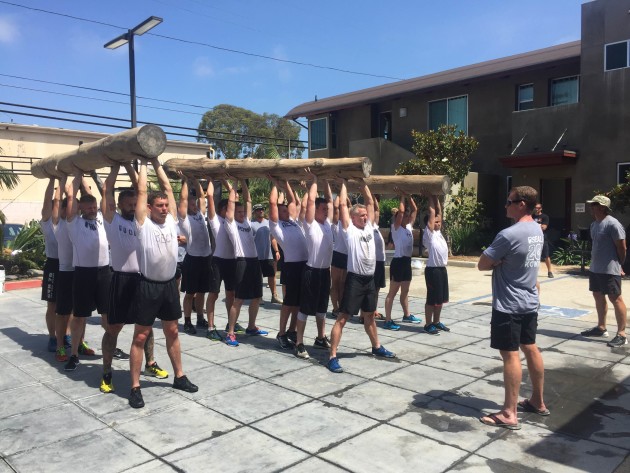Mark’s Blog: SOURCING SEALFIT POWER
By Mark Divine
With the CrossFit Games wrapping up this past weekend, I have a memory I’d like to share that speaks to how a good training program builds and tests one’s ability to transcend perceived exhaustion and access deep reservoirs of additional power, an invaluable skill in competition and even more so in combat.
What dog are you feeding, Mark?
I was competing in the Masters division at the CrossFit Games Open several years ago when I confronted myself with this question. It was late in the WOD, the clock nearing the 17-minute deadline. My strength sapped by a flood of burpees, I had just failed my third attempt at what was a heavy snatch (for me!). I watched anger well up as I temporarily lost control and launched a boot at the barbell. I looked up at the clock and could hear the fear dog growling as the clock ticked down. I needed to get back to the basics of my Unbeatable Mind skills quickly.
The physiological aspects of the SEALFIT training regimen can be explained through the lens of exercise physiology. Terms like stamina, work capacity, energy pathways, catabolic versus anabolic training and over-training effect are typical definitions that frame the discussion. And that is all fine and good.
But understanding the external physiological effect of the training just scrapes the surface – the next – and I believe more important level – is to understand the inner, subjective training effect through experience, and optimizing that for mission accomplishment. For example, sports scientist Tim Noakes, MD, believes that the sensations of fatigue we experience during extreme exercise are not because we’re running out of energy stores. Rather, per Noakes “Central Governor” theory, the brain issues stimulus that creates feelings of fatigue to back us down to homeostasis. In his studies, Noakes noted that during a hard effort, like a long SEALFIT OPWOD or 20X Challenge, one way to forge more grit is to simply not give in to the feeling of fatigue.
The warrior athlete learns to modify his or her physiology through the mind…and to expand the threshold of acceptable pain. We learn to embrace training induced pain to a known, or a new threshold, while also being sensitive to injury inducing pain when overdoing it. This dovetails with our concept of controlling your mental response to failure; such as I was experiencing in that CrossFit Open workout. The moment you let your guard down and allow the experience of fatigue dominate your thoughts, or you imagine that you are failing at the job, the amygdala triggers the stress response and your “central governor” exploits the thought sending a rush of even more fatigue. The cue has been given and you start to shut down. Game over.
This is the scenario I talk about when I discuss starving the Fear Wolf by feeding the Courage Wolf. These two are vying for attention every moment and never leave our sides. When things aren’t going well, the Fear Wolf growls wildly to get fed, and often does. The Courage Wolf, on the other hand, waits with quiet humility, often starving for attention. Hence the question that I pose frequently in training: What wolf are you feeding now? Be mindful and honestly note the answer. It will reveal deep patterns of positive and negative bias in your life.
The good news is that starting today, right now, you can train yourself to feed the courage wolf and have a positive bias at all times.
Here’s how you do it: At the first sign of excessive fatigue or failure, turn your attention inward and slow things down enough to pay close attention to what’s going on inside your head. You will notice that you’re welling up with frustration, fear or agitation. Take three slow, deep breaths. As you breathe in and out, put forth this question:
What wolf am I feeding?
Pose the question and take notice of the feelings you are dealing with and follow those feelings to their origin—the dominating thoughts that spurred their creation. Now starve the fear wolf by breaking the cycle of negative thinking and fearful emotions with a positive statement of power, one that feeds the courage wolf. An example: “Easy day…I’ve got this!” and “Feeling good, No Sweat.”
Power statements break up the fear feeding frenzy and draw up the courage wolf by his scruff. To feed the courage further, energize your posture and charge up your mind with images of peak output of power. See fear wolf cringing in failure and courage wolf as full of power and success. These images, harnessed with emotion, will affect your physiology in subtle, positive ways that have huge impact on the work capacity you’re able to produce over time, or in a clinch.
So after throwing a front kick at the barbell and taking notice that I was about to feed my Fear Wolf with abandon, I stopped, took three breaths, and cultivated an image of snatching the bar up above my head with perfect form.
I fed the Courage Wolf with this internal saying: “I’ve got this. Easy day. Hooyah! Throw the heart into this one Mark.”
I could feel the fear melt away.
I approached the bar and snatched it up above my head almost effortlessly. I was back in the game.
Learning to manage your internal states, and to starve fear by feeding courage, are key to the internal work of SEALFIT’s Unbeatable Mind training. You will want to become skilled at this enhanced training method.
Another crucial aspect of optimizing performance, for work, competition and life in general, is dialing in your nutrition. This will be the subject of next week’s blog.
Until then, train hard and feed the Courage Wolf.
Hooyah!
Mark Divine


Leave a Reply
You must be logged in to post a comment.